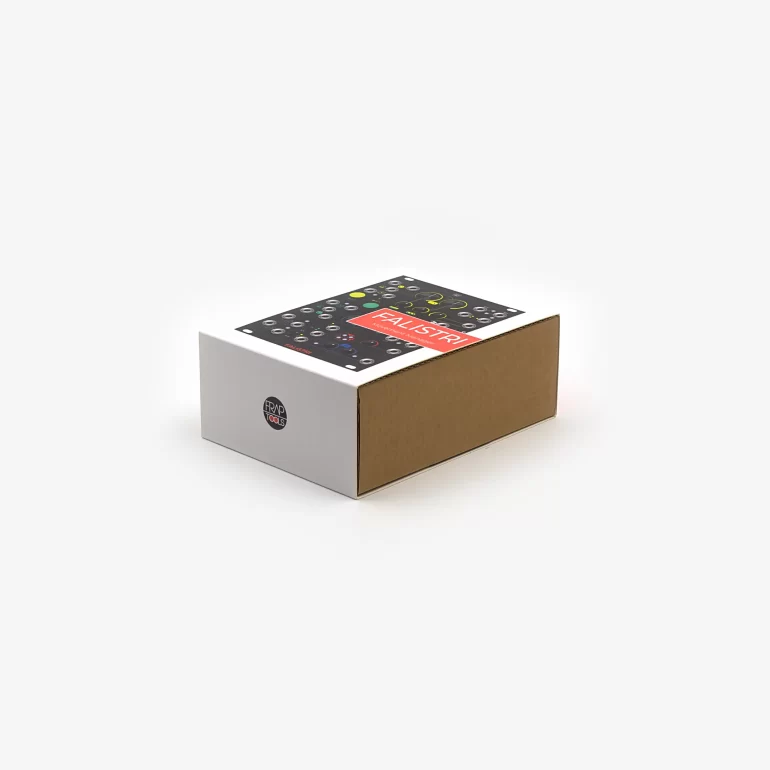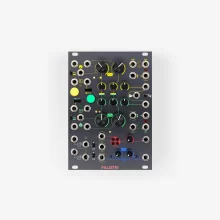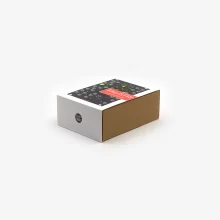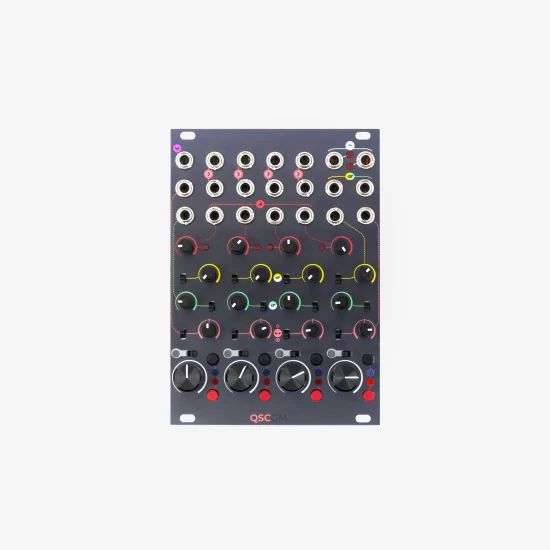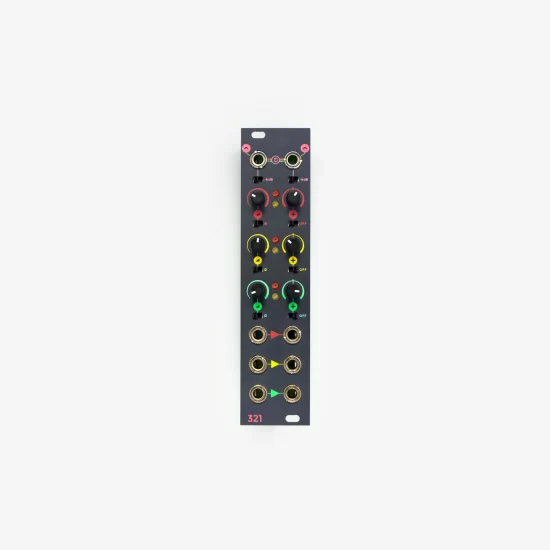Falistri
Movement Manager
falistri / faˈlistri / s.f., plural [Modenese dialect, probably from Latin fauilla, ‘spark’] – ‘sparks’. One cannot think about a lively bonfire without sparks crackling and dancing through the air. ‘Falistri’ is what lights up your patch and takes care of how it moves, through sparks, motions, and crackles.
OR:
390,00 € + VAT
In stock
Description
The FALISTRI is a fully analog multipurpose movement manager designed to generate and edit voltages to easily accomplish any patch.
The module can be divided into two big parts: in the upper two-thirds of the panel take place two specular function generators, while the lower third is composed of a dual cascaded frequency divider, a linear slew limiter, and a four-quadrant multiplier.
Key Features
We designed the generators to quickly and intuitively achieve the function needed.
The two generators are identical: they have the same controls and the same output set.
The Time Scale Switch lets you quickly swap from LFO to oscillator – and it tracks pretty well!
You can freely morph from Logarithmic to Linear to Exponential shapes without changing the time needed to complete Rise or Fall.
When you use FALISTRI as a modulator, it means that you can change the shape without changing the duration of your envelope or LFO.
When you use it as an oscillator, it means that you can change the waveform without changing the frequency!
You can have a Logarithmic Rise and Logarithmic Fall, Linear Attack and Logarithmic Fall, or any other combination of the three modes.
You can always blend between these shapes and achieve complex shapes both when generating CVs and audio signals.
Interacting with your patch is essential for us so that you can fire the envelopes both through an external trig/gate or the built-in buttons.
You can also use it to override the incoming gates and hold the envelope high for dramatic effects – it’s all about the performance!
Each function can work in three ways:
- Loop – The envelope retrigs itself, becoming an LFO or an oscillator.
- Transient – An attack-release envelope, with no sustain and no gate information.
- Sustained – An attack-hold-release envelope whose duration depends on the gate length.
You can automatically Switch from either Transient or Sustained to Loop through a gate input.
Connect the two sections for complex envelopes or waveforms!
With the Quadrature mode:
- The end of the yellow ‘Rise’ triggers the start of the green ‘Rise’;
- The end of the green ‘Rise’ triggers the start of the yellow ‘Fall’;
- The end of yellow ‘Fall’ triggers the start of green ‘Fall.’
Use it at audio rate to obtain a sort of trapezoid oscillator!
Each generator has five outputs:
- unipolar 0V/+10V;
- bipolar -5V/+5V;
- attenuverted -10V/0/+10V;
- End of Rise Gate
- End of Fall Gate
An additional Max output works as an analog OR, outputting the highest voltage currently generated by the two envelopes. It can create complex envelopes (like in Quadrature mode) or weird waveforms.
FALISTRI has two semi-normalled frequency dividers (or flip-flops).
Patch a gate signal to the first input obtain two gate streams of half and a quarter of its frequency. It works great with random clocks!
Use it with audio-rate signals to generate sub octaves.
You can patch two separate signals and use the frequency dividers independently.
This circuit works as a “bipolar DC-coupled linear VCA.” You can do:
- AM;
- RM;
- Voltage processing and scaling.
By default, it is semi-normalled to the green bipolar output and the yellow unipolar output, allowing you to use FALISTRI as a stand-alone synth voice.
A dedicated slew limiter allows you to smooth any voltage transition.
Create the classic portamento/glide effect, or get creative and experiment with the independent controls for the rise and fall stages.
You can even use it as a rudimentary third AR envelope!
Learn
Learn
Learn
Additional information
| Weight | 0,365 kg |
|---|---|
| Dimensions | 15,6 × 11,7 × 6 cm |
Specs
Size | 18 HP |
Depth | 38 mm |
Current draw | 170 mA @ +12 V 170 mA @ -12 V |
Recommended warmup time | 30 min |
CV input impedance | > 90 KΩ |
Trig/Gate input impedance | > 90 KΩ |
Input trigger amplitude threshold (Trig/Gate input) | > 1.5 V |
Input trigger maximum frequency at 1.5 V (Trig/Gate input) | > 6 KHz |
Input trigger minimum pulse period at 1.5 V (Trig/Gate input) | < 80 μs |
Force Loop input impedance | > 50 KΩ |
Input trigger amplitude threshold (Force Loop input) | > 3 V |
Input trigger maximum frequency at 3 V (Force Loop input) | > 6 KHz |
Input trigger minimum pulse period at 3 V (Force Loop input) | < 80 μs |
Single stage (Rise or Fall) with long times | From ~ 0.9 ms to ~ 10 s |
Complete cycle with long times | From ~ 1.9 ms to ~ 20 s From ~ 520 Hz to ~ 0.05 Hz |
Complete cycle with short times | From ~ 0.16 ms to ~ 1.5 s From ~ 6.1 KHz to ~ 0.67 Hz |
Generator voltage output unipolar amplitude | > 10 V |
Generator voltage output bipolar amplitude | > ±5 V |
Generator voltage output unipolar offset (in Rest stage) | < 35 mV |
Generator voltage output impedance | > 100 Ω |
Waveshapers amplitude tolerance (e.g. overshoot) | < 1 % |
Generator V/oct tracking tolerance (audible range) | < ±5 ȼ |
MAX output impedance | > 100 Ω |
MAX output amplitude | > 10 V |
Generator gate output offset | ± 20 mV |
Generator EOF output minimum positive pulse period | 1 ms |
Generator gate outputs impedance | > 220 Ω |
Generator gate outputs amplitude | > 3 V |
Frequency divider input maximum trigger frequency (at 3V) | 40 KHz |
Frequency divider minimum input pulse period | < 10 μs |
Frequency divider unipolar output amplitude | ~ 9.5 V |
Frequency divider bipolar output amplitude | > ±4.5 V |
Frequency divider output offset | < 50 to < 100 mV |
Frequency divider input impedance | > 90 KΩ |
Frequency divider output impedance | > 220 Ω |
4QM dynamic range | ~ 78 dB |
4QM residual THD+N | ~ 0.015 |
4QM maximum allowable gain | ~ 6.5 dB |
4QM high frequency roll-off | 36 KHz |
4QM input impedance | > 90 KΩ |
4QM output impedance | > 100 Ω |
Slew Limiter minimum slew rate | 1 to 1.25 V/ms |
Slew Limiter maximum slew rate | ~ 0.6 V/s |
Slew limiter input impedance | > 28 KΩ |
Slew limiter output impedance | > 100 Ω |
More details on the Manualone.
FAQ
A. Use
Our modules are packed with high-quality components that demand a proper power supply and can get sensibly warm.
That is its normal temperature and we can guarantee their performance.
Even though both inputs can perform the same task, i.e., modifying the length of the rising and falling segments of the generated function, their concept is the opposite.
Rise and Fall CV inputs are designed to control the duration of the individual segments so that higher voltages provide more extended envelopes or LFOs. In contrast, the V/oct input is used mainly to control the pitch of a generator that is oscillating at audio rate: in this latter scenario, higher voltages equal to higher notes, i.e., shorter cycles.
Even though both inputs can perform the same task, i.e., modifying the length of the rising and falling segments of the generated function, their concept is the opposite.
Rise and Fall CV inputs are designed to control the duration of the individual segments so that higher voltages provide more extended envelopes or LFOs, while the V/oct input is used mainly to control the pitch of a generator that is oscillating at audio rate: in this latter scenario, higher voltages equal to higher notes, i.e., shorter cycles. This is why they behave oppositely.
B. Design
We have two main kinds of capacitors.
The first one is necessary to AC-couple the audio signal: they prevent any unwanted DC offset, and they offer protection against wrong connections. For this reason, you can patch nearly every input to every output, and the worst thing that can happen is some pops or some silence.
The second one is power filters to guarantee a cleaner current flow across the case. They might sound a bit over the top, but we must remember that a Eurorack system is not something that comes straight out of the factory. Instead, every Eurorack setup is unique and may change according to the musician’s need. For this reason, we want to add as much protection as we can, both to avoid issues with our modules and to ensure that even the other modules behave correctly. We use a wide mix of capacitors in our modules: ceramic, electrolytic, tantalum, and multilayer. They can be assembled thru-hole or SMD, according to what gives the best balance between result and space. For example, all the electrolytic capacitors are mounted thru-hole because they perform better according to our tests.
However, the capacitors have zero impact on the power draw, on which you can read in this other FAQ.
Power draw should always be related to what a module does.
Generally speaking, there are modules like SAPÈL that undoubtedly consume more than other random generators. However, SAPÈL is a double module, so a fair comparison would be between it and a pair of similar modules. The same can be said for FUMANA, the most power-demanding filter bank. However, it is also the only Eurorack filter bank with 32 analog bandpass filters, half of which have a 48 dB/oct slope. So, also in this case, a fairer comparison would be between FUMANA and TWO other 16-band filter banks, which leads to similar power consumptions.
More in detail, we engineer our modules to be safe to use. To protect both the modules and the rest of the case, we add a proper buffering stage to every input and output: even if a single buffer doesn’t draw that much power, all the ins and outs piled together can significantly impact the final power draw.
We made some minor updates on the front panel after we released the BRENSO oscillator. We removed the logos from all of our modules, and we updated the semi-normalization graphics to be closer to the BRENSO. Read more here.
C. Shop
Yes! We opened our online store in October 2022. Check out the full catalog!
Our resellers receive our modules exclusively through our distributor, so we do not have access to the individual shops’ orders or stocks.
We restock every module at least once over a year: we focus on a module’s batch at a time, then we move on to the next one, and so on.
If you want an estimated delivery time for a specific module, drop us a line! We’ll be happy to answer you.

